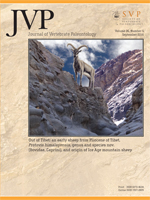Chukimys favaloroi, new genus and species, is added to the past diversity of sigmodontine rodents, the largest subfamily of Neotropical mammals. It is based on a maxillary with the entire tooth row and both first and second lower molars collected in sediments of the Brochero Formation (Late Pliocene) that crop out in Córdoba Province, Argentina. The new genus represents a small rodent (about 40 g) and has a unique combination of traits, including a zygomatic plate with deeply excavated anterior border and conspicuous zygomatic spine, incisive foramen reaching the level of the protocone of the first upper molar, palate narrow and flat, molars moderately hypsodont, and the first lower molar four-rooted. The new sigmodontine shows similarities with several extant members of the tribes Phyllotini and Reithrodontini, as well as with the extinct Dankomys vorohuensis from the Pliocene of Buenos Aires, Argentina. The comparisons performed suggest that Chukimys has anatomical features related to omnivory and the incorporation of hard material in its diet. Chukimys is the first fossil genus of sigmodontine described from central Argentina and probably represents a new member of the currently monotypic tribe Reithrodontini.
How to translate text using browser tools
1 September 2016
A New Genus of Sigmodontinae (Mammalia, Rodentia, Cricetidae) from the Pliocene of Central Argentina
Franck Barbiere,
Laura E. Cruz,
Pablo E. Ortiz,
Ulyses F. J. Pardiñas
ACCESS THE FULL ARTICLE





